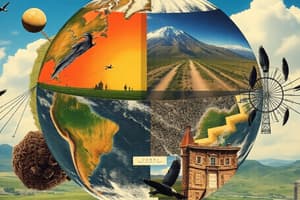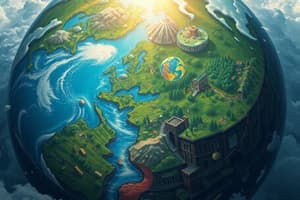Podcast
Questions and Answers
What is the highest layer of the atmosphere?
What is the highest layer of the atmosphere?
- Stratosphere
- Exosphere (correct)
- Mesosphere
- Thermosphere
Which layer of the atmosphere contains the ozone layer?
Which layer of the atmosphere contains the ozone layer?
- Thermosphere
- Stratosphere (correct)
- Mesosphere
- Troposphere
What is the approximate thickness of the oceanic crust?
What is the approximate thickness of the oceanic crust?
- 5 to 10 km (correct)
- 70 to 80 km
- 15 to 25 km
- 30 to 40 km
Which layer of the geosphere is primarily composed of silicate materials?
Which layer of the geosphere is primarily composed of silicate materials?
What is the name of the boundary between the crust and the mantle?
What is the name of the boundary between the crust and the mantle?
Which layer of the atmosphere is known for having the coldest temperatures?
Which layer of the atmosphere is known for having the coldest temperatures?
Which layer of the mantle is known as the lithosphere?
Which layer of the mantle is known as the lithosphere?
Which layer of the atmosphere is characterized by charged particles?
Which layer of the atmosphere is characterized by charged particles?
Which organism is classified under the biosphere?
Which organism is classified under the biosphere?
What is the layer of the atmosphere where weather occurs?
What is the layer of the atmosphere where weather occurs?
What type of crust is found under the oceans?
What type of crust is found under the oceans?
What concept did Vladimir Vernadsky popularize?
What concept did Vladimir Vernadsky popularize?
Which process describes how water moves into the atmosphere?
Which process describes how water moves into the atmosphere?
What percentage of all the water on Earth is made up of salty water?
What percentage of all the water on Earth is made up of salty water?
Which scientist is referred to as the father of modern geology?
Which scientist is referred to as the father of modern geology?
How did Alexander von Humboldt contribute to Earth System Science?
How did Alexander von Humboldt contribute to Earth System Science?
Which layer of the Earth is described as the innermost layer of Earth’s interior?
Which layer of the Earth is described as the innermost layer of Earth’s interior?
What principle did James Lovelock propose?
What principle did James Lovelock propose?
What effect does water running through fertile soil have?
What effect does water running through fertile soil have?
What does the concept of uniformitarianism imply according to James Hutton?
What does the concept of uniformitarianism imply according to James Hutton?
Which of the following gases is the most abundant in the atmosphere?
Which of the following gases is the most abundant in the atmosphere?
What aspect of Earth did Vladimir Vernadsky theorize would lead to sustainability?
What aspect of Earth did Vladimir Vernadsky theorize would lead to sustainability?
Which scientist studied the transfer of heat around Earth and its effect on organisms?
Which scientist studied the transfer of heat around Earth and its effect on organisms?
What process did James Hutton conceptualize that transforms rock and soil?
What process did James Hutton conceptualize that transforms rock and soil?
What occurs in the asthenosphere that allows the lithospheric plates to move?
What occurs in the asthenosphere that allows the lithospheric plates to move?
Which of the following best describes the composition of the core of the Earth?
Which of the following best describes the composition of the core of the Earth?
What percentage of Earth's hydrosphere is composed of saltwater?
What percentage of Earth's hydrosphere is composed of saltwater?
What do the living organisms in the biosphere primarily interact with?
What do the living organisms in the biosphere primarily interact with?
Which of these is NOT a component of the four primary subsystems of Earth?
Which of these is NOT a component of the four primary subsystems of Earth?
Which biome is characterized by its ability to support various plant and animal life?
Which biome is characterized by its ability to support various plant and animal life?
What is the primary characteristic that allows the lower mantle to remain solid?
What is the primary characteristic that allows the lower mantle to remain solid?
Which of the following best defines a biome?
Which of the following best defines a biome?
What is the primary role of the oceans in relation to climate?
What is the primary role of the oceans in relation to climate?
How does soil moisture influence surface temperature?
How does soil moisture influence surface temperature?
What aspect of the geosphere primarily impacts climate?
What aspect of the geosphere primarily impacts climate?
What effect does a mountain range have on local weather patterns?
What effect does a mountain range have on local weather patterns?
How do plants and trees influence atmospheric carbon dioxide levels?
How do plants and trees influence atmospheric carbon dioxide levels?
What happens when a large number of plants and trees are removed from an area?
What happens when a large number of plants and trees are removed from an area?
What is the role of the hydrosphere in the climate system?
What is the role of the hydrosphere in the climate system?
What effect do dust particles in the atmosphere have on climate?
What effect do dust particles in the atmosphere have on climate?
What is the primary product of photosynthesis in plants and photosynthetic bacteria?
What is the primary product of photosynthesis in plants and photosynthetic bacteria?
Through which processes does carbon from the land reach the oceans?
Through which processes does carbon from the land reach the oceans?
Which of the following is a unique characteristic of Earth related to the oxygen cycle?
Which of the following is a unique characteristic of Earth related to the oxygen cycle?
What happens to oxygen during aerobic respiration?
What happens to oxygen during aerobic respiration?
Which organisms are known to perform photosynthesis and produce oxygen gas?
Which organisms are known to perform photosynthesis and produce oxygen gas?
What is a significant pathway through which carbon is converted into fossil fuels?
What is a significant pathway through which carbon is converted into fossil fuels?
What role do biogeochemical cycles play in Earth's ecosystems?
What role do biogeochemical cycles play in Earth's ecosystems?
Which process is primarily responsible for the consumption of oxygen in ecosystems?
Which process is primarily responsible for the consumption of oxygen in ecosystems?
Flashcards
Noosphere
Noosphere
The sphere of human consciousness and reason, theorized to be the final stage in the evolution of organisms.
Vladimir Vernadsky
Vladimir Vernadsky
A Russian mineralogist and geochemist who popularized the concept of the noosphere.
Sustainability
Sustainability
The capacity of Earth to continue supporting human life without depleting natural resources.
Alexander von Humboldt
Alexander von Humboldt
Signup and view all the flashcards
Uniformitarianism
Uniformitarianism
Signup and view all the flashcards
James Hutton
James Hutton
Signup and view all the flashcards
Weathering
Weathering
Signup and view all the flashcards
Gaia hypothesis
Gaia hypothesis
Signup and view all the flashcards
Troposphere definition
Troposphere definition
Signup and view all the flashcards
Stratosphere function
Stratosphere function
Signup and view all the flashcards
Mesosphere feature
Mesosphere feature
Signup and view all the flashcards
Thermosphere phenomenon
Thermosphere phenomenon
Signup and view all the flashcards
Oceanic crust thickness
Oceanic crust thickness
Signup and view all the flashcards
Continental crust thickness
Continental crust thickness
Signup and view all the flashcards
Moho definition
Moho definition
Signup and view all the flashcards
Mantle composition
Mantle composition
Signup and view all the flashcards
What is the asthenosphere?
What is the asthenosphere?
Signup and view all the flashcards
What is the lower mantle?
What is the lower mantle?
Signup and view all the flashcards
What is the Earth's core?
What is the Earth's core?
Signup and view all the flashcards
What is the hydrosphere?
What is the hydrosphere?
Signup and view all the flashcards
What is the biosphere?
What is the biosphere?
Signup and view all the flashcards
What are biomes?
What are biomes?
Signup and view all the flashcards
What is the atmosphere?
What is the atmosphere?
Signup and view all the flashcards
What is the geosphere?
What is the geosphere?
Signup and view all the flashcards
What is the crust?
What is the crust?
Signup and view all the flashcards
What is the mantle?
What is the mantle?
Signup and view all the flashcards
What is the core?
What is the core?
Signup and view all the flashcards
Climate Regulation by Oceans
Climate Regulation by Oceans
Signup and view all the flashcards
Soil's Impact on Climate
Soil's Impact on Climate
Signup and view all the flashcards
Topography and Wind
Topography and Wind
Signup and view all the flashcards
Dust's Role in Climate
Dust's Role in Climate
Signup and view all the flashcards
Biosphere's Influence on Climate
Biosphere's Influence on Climate
Signup and view all the flashcards
Deforestation's Effect on Climate
Deforestation's Effect on Climate
Signup and view all the flashcards
Greenhouse Gases and Climate
Greenhouse Gases and Climate
Signup and view all the flashcards
Hydrosphere as Climate Regulator
Hydrosphere as Climate Regulator
Signup and view all the flashcards
Photosynthesis
Photosynthesis
Signup and view all the flashcards
Carbon Cycle
Carbon Cycle
Signup and view all the flashcards
How does carbon reach the oceans?
How does carbon reach the oceans?
Signup and view all the flashcards
Fossil Fuels
Fossil Fuels
Signup and view all the flashcards
Oxygen Cycle
Oxygen Cycle
Signup and view all the flashcards
Oxygen Production
Oxygen Production
Signup and view all the flashcards
Oxygen Consumption
Oxygen Consumption
Signup and view all the flashcards
Biogeochemical Cycle
Biogeochemical Cycle
Signup and view all the flashcards
Study Notes
Unit 3: Introduction to Earth System Science
- Unit 3 of the study guide covers Introduction to Earth System Science, with lessons on Earth System Science, The Four Subsystems of Earth, and Earth's Climate System along with the Biogeochemical Cycles.
- The study guide also includes a list of essential questions along with a review section for each lesson.
Lesson 3.1: Introduction to Earth System Science
- The objective of lesson 3.1 is to show the contributions of notable scientists to the understanding of Earth's systems and cite the reasons why studying Earth's systems is relevant to society.
- Warm-up activity involves calculation of carbon dioxide emissions using a carbon footprint calculator.
- Scientists have built the foundations for understanding Earth systems.
Lesson 3.2: The Four Subsystems of Earth
- The objective of lesson 3.2 is to describe each major subsystem of Earth.
- The subsystems of Earth are the atmosphere, geosphere, hydrosphere, and biosphere.
- The atmosphere is made up of gases, the geosphere is comprised of soil, rocks, and minerals, the hydrosphere is made up of water, and the biosphere encompasses all living things on Earth.
Lesson 3.3: Earth's Climate System
- The objective of lesson 3.3 is for students to explain the interactions between Earth subsystems and external forces along with their impact on Earth's climate system.
- Warm-up activity involves describing an assigned ecosystem and identifying components that belong to the major subsystems.
Lesson 3.4: The Biogeochemical Cycles
- The objective of lesson 3.4 is to identify biogeochemical processes and describe the movement of matter.
- Earth's subsystems consist of compounds essential for life such as water, nitrogen, carbon, and oxygen.
- Warm up activity for lesson 3.4 involves reviewing a video about the fall of a leaf.
Studying That Suits You
Use AI to generate personalized quizzes and flashcards to suit your learning preferences.




